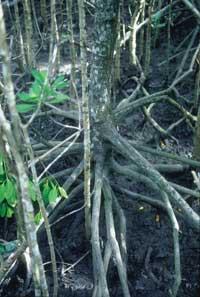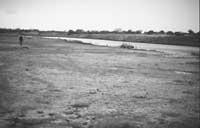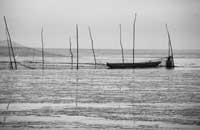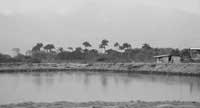Shrimp Blues: mangroves

The bloody roots of Rhizophora give the mangroves an indifferent aspect.
Distribution of distribution Distribution
The sea is the only area in the world not colonized by cormofitos (superior plants with vascular tissue). Although they dominate terrestrial ecosystems, very few species (Thalassa, Zostera, Posidonia...) have managed to live in the sea. The Cormofitos do nothing but wet their feet in the salty waters of the sea.
Some cormofitos are able to stay in the intertidal zone, but only in areas of low marine influence. Of all the plant formations that live in the interphase earth/sea, undoubtedly, those that present a biomass and a higher structural complexity are the mangroves. This generic name includes the wooded communities that inhabit the intertidal of the tropics and subtropics. The distribution of these formations is limited to low latitudes, but their limits are very variable according to the times.
In areas exposed to temperate marine currents, such as the Caribbean, mangroves can reach a latitude of 27º (for example, on the coast of Florida). On the contrary, on the cold current coast, which makes the climate also drier, very few degrees away from Ecuador. For example, on the Pacific coast of South America, near the Humboldt current, mangroves only reach the limit between Peru and Ecuador (up to a latitude of 3º).

To live in such a stressful environment, the plants have had to adapt especially. The roots and tissues must withstand a high concentration of marine salts; the anaerobic environment prevents the respiration of the roots and must adapt to stay firm in so mobile root. On the other hand, seeds must have capacity for growth in these extreme conditions. Despite the different efficiency, the mangrove plants have managed to overcome all these barriers.
Most of the cellular processes of the cormofitos cannot be carried out in the composition and marine ionic concentration, so strategies should be used to correct the active excretion of salt in leaves and roots, their elimination by deposit in old leaves that are going to lose or the “theft” of water to the sea modifying the osmotic concentration of the toad.
Mangladi trees have selected at least one of these options. Rhizophora or red mangrove blocks the entry of salt into the cell membrane. The osmotic pressure of the fluids of its roots is very high (35-60 atm), superior to that of sea water (25 atm). However, the salt concentration is not very high (between 1,2 and 1.5 mg/l) and the increase in osmotic concentration is achieved by the release of organic products. The water is introduced into the plant by osmotic processes and microfiltration.
The Avicennia germinans or black mangrove captures a lot of salt to raise its osmotic concentration and thus is able to “absorb” water. To avoid the imbalance between the different ions, their leaves contain glands that actively expel salt. These are located in the epidermia and their enzymes have an activity dependent on the Na/K ratio.

The land of the mangroves has problems of anoxia, because the hollows are full of water and not of wind, and in addition the organic load is very active, decreasing the available oxygen. Therefore, oxygen transfer mechanisms are needed from above to the roots. Rhizophon has lenticielas (respiratory pores) in its roots in the shape of legs. The Mora and Pelliceria also have lenticelas, but on the roots of the boards. The adaptation of Avicennia and Laguncularia is the most interesting: from its roots leave the neumoforos, roots that grow with negative geotropism, and leave the water, at least in bajamar. Seen from the outside they resemble the chimneys, but inside they are filled with parenchymal sponges that allow the exchange of gases.
Once the thirst is quenched and ready to breathe, the mangrove trees must be erected in the moving environment. Rooted, with mud and water, it is very mobile, since every day you have to feel the strength of the pleamar and the bajamar (the tide, for example, can reach the four meters in the Pacific). The most spectacular adaptation has been that of Rhizopha: the trunk rises with dilapidated roots and it can be said that it floats on the mud. Avicennia and Laguncularia, however, have the root on radial surfaces, which allows the base to be greater. Pelliceria and Mora, as we have said, have roots of boards.
With all living conditions, these species must be able to arrive; it is not easy for the plants to be submerged in all the pleamares. So they have to grow before. This evolutionary pressure has generated the convergence of all mangrove trees. Mangrove seeds are very large (for example, Mora seeds are 1000 g or more). They are all bivalves, that is, they cool on the branches so as not to waste time and have the same way to not fall face down. As if it were not enough, they are also able to float to arrive, if necessary, to another beach by effect of the current.
Ecosystem of mangroves

The mangroves are not diverse ecosystems, since there are few plant species that inhabit. In some cases this problem reaches the extreme: there are mangroves with a single species of tree.
Beware of what you said. Ecosystems are not mere lists of species and the number of species is not always the most important. In fact, ecosystems are not found in closed sets, and their relationships weave a network. Despite the scarcity of plant species, the processes that occur in mangroves have a great importance in coastal ecosystems.
The leaves of the mangroves have a great variety of foods and are the basis of a rich trophic network. Many species are forced to resort to mangroves to overcome a phase of life. Therefore, the disappearance of mangroves could have an unpredictable impact on the rest of coastal ecosystems. Things are not like in forests, where the movement of food is almost vertical; in mangroves, as in aquatic ecosystems, the horizontal characteristic is very important.
... and locustins

It is more important than we think, our preferences when sitting at the table and your changes. The economies of the Third World countries supply raw materials to the First World countries and are cheap. Normally, each country sells one or two products at this international fair. Therefore, when our preferences change from one product to another (Arab coffee, for example, robust coffee) or when suddenly anything becomes “poisonous” (sugar, for example), in these countries huge economic imbalances occur. How hard are the laws of the market!
The following explains the history of lobster (shrimp, as is known in Ecuador), to see that a product can totally alter the management and state of the medium. And also to realize that all these processes are closer to what we think.
Kamarone or Pennaeus vannamei is a species similar to our prawns. He lives in the Pacific. Their life cycle is known: their life begins in the high seas, where the females go to spawn their eggs; after passing the larval phase, the postlarva moves to the coast, to the estuaries, in search of places rich in nutrients and, normally, between the roots of the mangroves, where they live, as background organisms, to return to the sea when they arrive.

The shrimp has always been contemplated by fishermen, with catches close to 8,000 t/year between 1979 and 1989. In 1969 he began to devote himself to aquaculture, although initially in small quantities. Ten years later, the annual production was 4,000 tons, less than it had still been captured at sea. But that year it began to grow exponentially becoming the third source of foreign currency in Ecuador (after oil and banana). Production in 1989 was 70,000 tons.
The camera is used almost exclusively for export, since only the stolen ones enter the national market. The main buyer has been the United States, but in recent years the importance of the European market has increased, especially Spanish (146 million dollars in 1992).
The aquaculture of the chambers begins with the obtaining of postlarvae, of three different forms. The simplest, and the most used, is postlarval fishing. Around this activity almost 10,000 people work on the Ecuadorian coast, some throughout the year, but most for a few months. Not all postlarvae are valid: The genus Pennaeus has three species in Ecuador and is only used in Pennaeus vannamei. The others throw themselves, usually to the beach and die there. On the way from the sea to the seeds die a lot, almost 80% of the postlarvae.
The second system does not capture postlarin but pregnant females. These are sold to laboratories to meet the cycle until the end. In other areas, rarely, the entire cycle, including reproduction, is done in the laboratory. This technique would allow the camera industry to improve the variety, increasing productivity. In this way, the exploitation without measures would also be reduced.

After this phase, the postlarvae are sold to cameras. The purchase of postlarvae is the most expensive part of the entire process, at least for semi-extendable cameras. In 1984, with the high price of postlarvae, it represented 44% of the expenses.
Most cameras are not something of the other world: a ground pool that is supplied with water to a network of channels. The cameras feed on feed until they get a suitable size and weight, so they empty the pool and are captured on the ground as if they were twenty. Usually in this process, high-risk antibiotics are used due to the high risk of diseases. Water also changes often so that high concentrations of nutrients do not imply an excessive growth of algae. In this way, these companies generate sufficient pollution. The development of this activity has been very harmful to the Ecuadorian environment, especially for marine ecosystems. And not just for the problems we have mentioned above.
The chambers are available in many cases in mangroves or in salt soil. Of the 118,000 Ha used as a camera in 1989, 38,500 were in salt soil and 75% of this ecosystem disappeared. Another 38,000 hectares were made in places where mangroves were formerly, destroying 15% of this ecosystem (CLIRSEN 1987). The mangroves are disappearing faster and faster: In 1984-1987 the annual rate was 1.8% and in 1991 (CLIRSEN 1991).

Why has this happened? There are two reasons, on the technical side it is preferable to locate the pool near the water, thus reducing the pumping costs. The second is unfortunate: In Ecuador, as in Spain, the maritime and terrestrial district is public. Its meaning? In Ecuador (so it was also in Spain) it has no owner and anyone can use it without giving a coin.
In addition, the correction of this process is not easy due to the conditions of this industry in Ecuador. A Ha to Kamaronera only contributes 0.59 tons, very little considering that they contribute more than a ton to Mexico, China or Honduras. The return of Ecuador is not obtained through productivity, but through the reduction of costs: low investments and low wages (5$ per day or less).
There are technologies to avoid mixing water, to remove the camera. There are also, in theory, laws in favor of mangroves. But as the ideology of most companies is to make money without investment, they have no will to make these changes. The capitalization of companies has changed this situation, but these are exceptions. How will the cameras blues follow?





